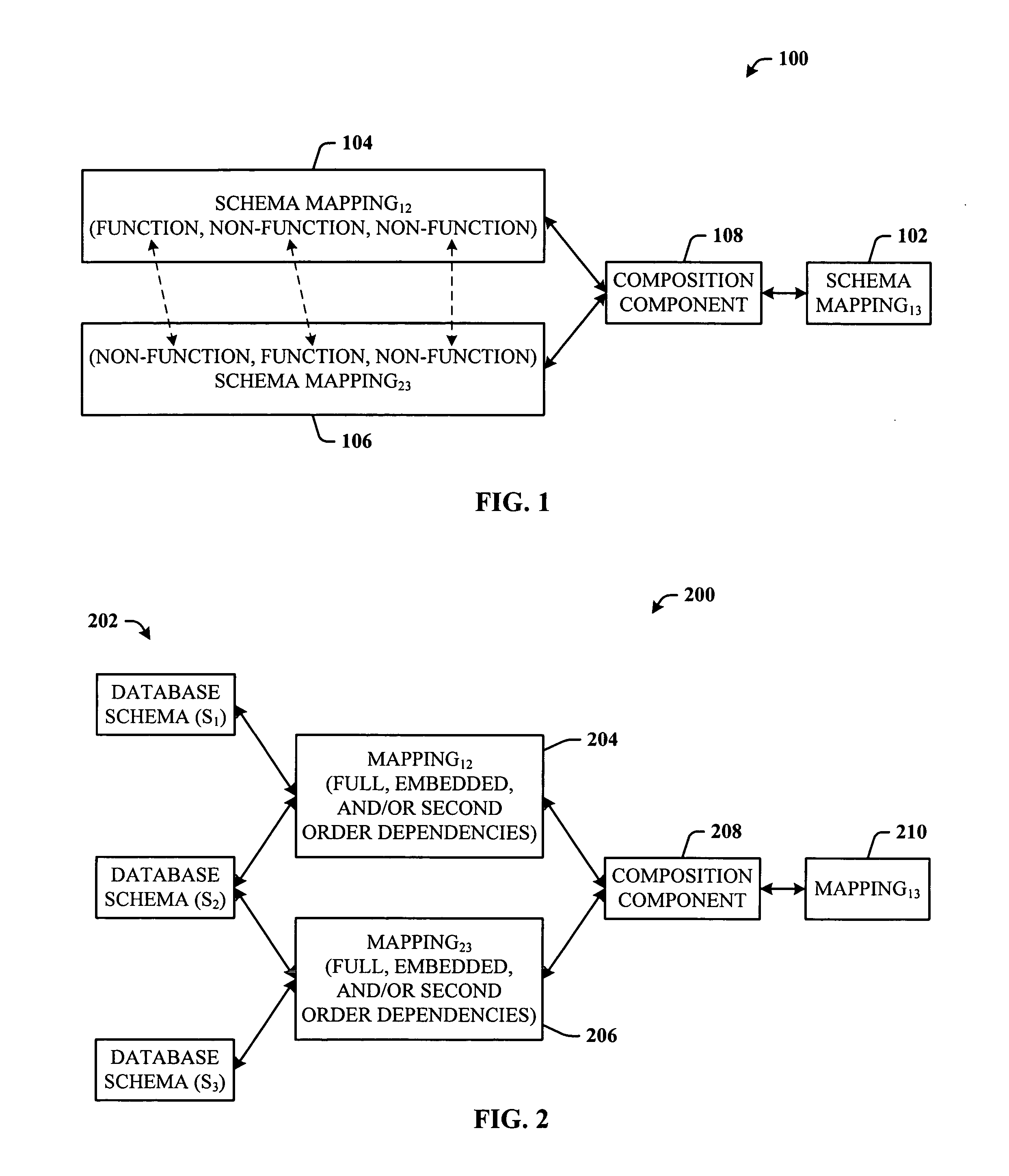System and method for composition of mappings given by dependencies
a mapping system and dependency technology, applied in computing models, instruments, electric/magnetic computing, etc., can solve the problems of inability to access data existing in one model/schema, time-consuming and resource-intensive conversion of data from one model to another model, and achieve the effect of facilitating the composition of schema mappings
- Summary
- Abstract
- Description
- Claims
- Application Information
AI Technical Summary
Benefits of technology
Problems solved by technology
Method used
Image
Examples
example 1
[0096] Given
[0097]Δ={R(1, 1)} and
[0098]Σ={R(xy)→S(xy), S(zz)→T(zz)},
[0099] the following is a valid deduction from Σ∪Δ:
1.R(1, 1)2.R(xy) → S(xy)3.R(1, 1) → S(1, 1)[2] x := 1, y := 14.S(1, 1)[1, 3]5.S(zz) → T(zz)6.S(1, 1) → T(1, 1)[5] z := 17.T(1, 1)[4, 6]
Here, rules 1, 2, and 5 are axioms, 3 and 6 are expand / rename, and 4 and 7 are resolution.
[0100] Within a deduction, a resolution step is called a σ2-resolution if the resolution is performed by unifying an atom from the signature σ2. The rule ξ obtained by σ2resolution is called σ2-resolvent. A rule ξ is a variant of ξ′ if it can be deduced from ξ′ without using resolution.
[0101] Following is an introduction of prerequisites for proving the correctness of the composition algorithm and the undecidability results.
[0102] If there is a deduction from a set of constraints Σ where the last line contains a constraint ξ, it can be said that ξ is deduced from Σ, which is written Σ├ξ. The L-deductive closure of Σ is
[0103] DC(L, Σ):=...
example 2
[0114] Given the deduction γ from Example 1, γ is:
1. 2. R(xy) → S(xy)3. R(v1v1) → S(v1v1)[2] x := v1 y := v14. R(v1v1) → S(v1v1)[3]5. S(zz) → T(zz)6. S(v1v1) → T(v1v1)[5] z := v17. R(v1v1) → T(v1v1)[4, 6]
[0115] The following replacements have been made for each rule:
[0116] 1. Axiom from Δ: removed by 1.
[0117] 2. Axiom from Σ; unchanged by 2.
[0118] 3. Expand rename: 1 replaced with v1 by 3.
[0119] 4. Resolution on 1, 3: trivial expand / rename by 4.
[0120] 5. Axiom from Σ; unchanged by 2.
[0121] 6. Expand rename: 1 replaced with v1 by 3.
[0122] 7. Resolution on 4, 6: resolution by 5.
[0123]γ is a valid deduction witnessing Σ├ξ since axioms from Δ are no longer used, and since replacements 1 through 5 above ensure that rule R is correctly deduced from the previously replaced rules. Additionally, Δ, ξ├R({overscore (c)}) is witnessed by a deduction γ′ which consists of the following sequence,
[0124] the axioms from Δ which were removed from γ to obtain γ′,
[0125]ξ followed by ξ′ obta...
example 3
[0142] Consider the CQ0-mappings m12 and m23 given by (σ1, σ2, Σ12) and (σ2, σ3, Σ23) where Σ12 is
[0143] R(xy)→S(xy)
[0144] S(xy), S(yz)→S(xz)
and Σ23 is
[0145] S(xy)→T(xy)
[0146] and where σ1, ={R}, σ2, ={S}, and σ3, ={T}. Together, these constraints say that R⊂S ⊂T and that S is closed under transitive closure. This implies tc(R)⊂T, where tc(R) denotes the transitive closure of R. It can be seen that the only CQ0=-constraints that hold between R and T are constraints of the form
[0147] R(xv1), R(v1, v2), . . . , R(vi-1, vi), R(vi, y)→T(xy)
but no finite set of them expresses tc(R)⊂T.
[0148] In fact, the composition m12•m23 is not even expressible in FO (first-order logic). Otherwise, given an FO sentence φ such that
[0149]εm12•m23 iff (R, T)φ
an FO formula ψ(xy) can be created, which is obtained by replacing every occurrence of T(uv) in φ with x≠u V y≠v. Then given a domain D with R⊂D2, Rψ[ab]
[0150] iff (R, D2−)φ
[0151] iff tc(R)⊂D2−(a,b)
[0152] iff εtc(R)
and therefore, ∀(x,y)...
PUM
 Login to View More
Login to View More Abstract
Description
Claims
Application Information
 Login to View More
Login to View More - R&D
- Intellectual Property
- Life Sciences
- Materials
- Tech Scout
- Unparalleled Data Quality
- Higher Quality Content
- 60% Fewer Hallucinations
Browse by: Latest US Patents, China's latest patents, Technical Efficacy Thesaurus, Application Domain, Technology Topic, Popular Technical Reports.
© 2025 PatSnap. All rights reserved.Legal|Privacy policy|Modern Slavery Act Transparency Statement|Sitemap|About US| Contact US: help@patsnap.com



